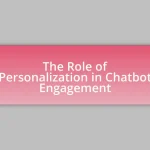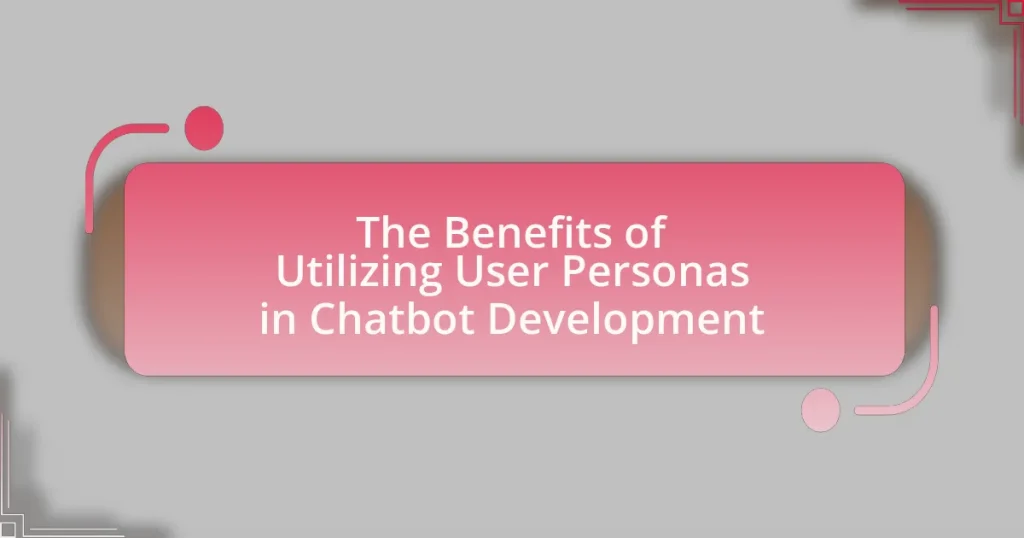User personas in chatbot development are essential tools that represent target users, guiding the design and functionality of chatbots. These personas are created through comprehensive user research, including data analysis and profiling, which helps developers understand user demographics, behaviors, needs, and goals. By utilizing user personas, developers can enhance user experience and engagement, leading to significant increases in user satisfaction and interaction rates. The article explores the creation, characteristics, and importance of user personas, as well as their impact on chatbot performance and design, providing insights into best practices and methodologies for effective implementation.
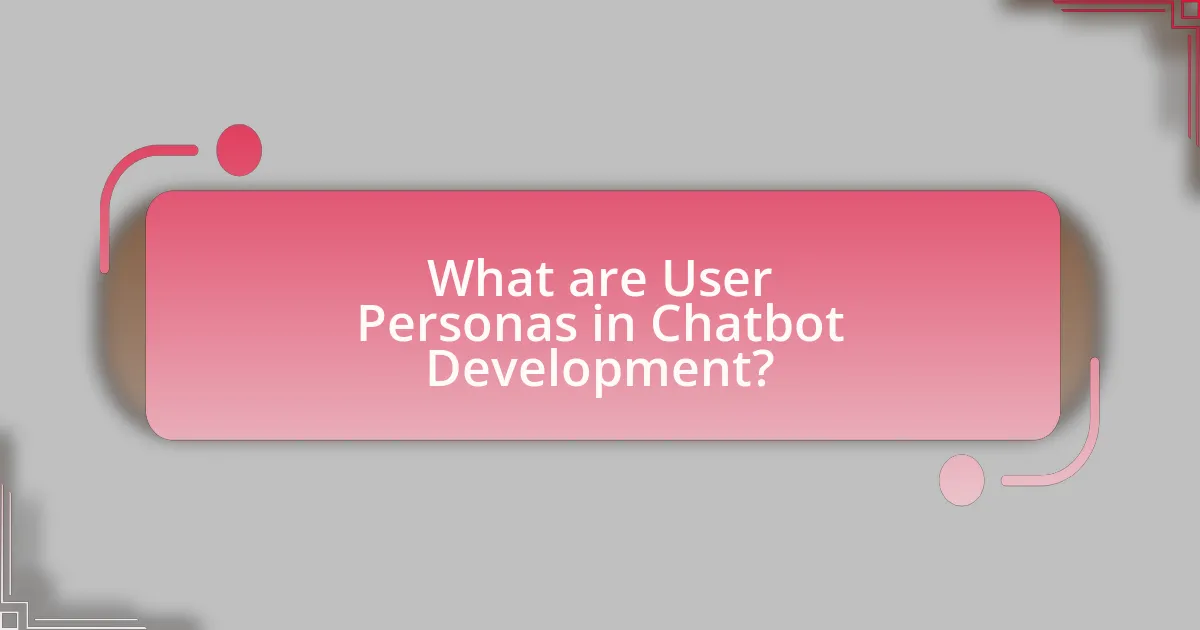
What are User Personas in Chatbot Development?
User personas in chatbot development are detailed representations of target users that guide the design and functionality of the chatbot. These personas are created based on user research, including demographics, behaviors, needs, and goals, which help developers understand how different users will interact with the chatbot. By utilizing user personas, developers can tailor the chatbot’s responses and features to meet specific user expectations, ultimately enhancing user experience and engagement. Research indicates that companies employing user personas in their design processes see a 20-30% increase in user satisfaction, demonstrating the effectiveness of this approach in creating more relevant and user-friendly chatbots.
How are user personas created for chatbots?
User personas for chatbots are created through a systematic process that involves research, data analysis, and user profiling. This process typically begins with gathering qualitative and quantitative data from potential users, which can include surveys, interviews, and analytics from existing platforms. The data collected helps identify user demographics, behaviors, needs, and pain points.
Once the data is collected, it is analyzed to segment users into distinct groups based on shared characteristics. Each group is then developed into a detailed persona that includes information such as age, occupation, goals, and preferred communication styles. This persona serves as a representation of the target audience, guiding the design and functionality of the chatbot to ensure it meets user expectations effectively.
The validity of this approach is supported by research indicating that user-centered design, which includes the creation of personas, significantly enhances user satisfaction and engagement. For instance, a study published in the Journal of Usability Studies found that incorporating user personas in design processes leads to a 50% increase in user satisfaction ratings.
What data sources are used to develop user personas?
User personas are developed using various data sources, including user interviews, surveys, analytics data, and market research. User interviews provide qualitative insights into user motivations and behaviors, while surveys gather quantitative data on user demographics and preferences. Analytics data from website or app usage reveals patterns in user interactions, and market research offers context on industry trends and competitor analysis. These combined sources ensure a comprehensive understanding of target users, facilitating the creation of accurate and effective user personas.
What characteristics define effective user personas?
Effective user personas are characterized by their specificity, relevance, and empathy. Specificity ensures that personas are based on detailed demographic and psychographic data, allowing for targeted design and development. Relevance means that the personas accurately reflect the actual users of the product, incorporating real user feedback and behavior patterns. Empathy involves understanding users’ needs, motivations, and pain points, which helps in creating solutions that resonate with them. Research indicates that well-defined user personas can improve product usability and user satisfaction, as they guide design decisions that align with user expectations and experiences.
Why are user personas important in chatbot development?
User personas are important in chatbot development because they help create tailored interactions that meet the specific needs and preferences of target users. By understanding the demographics, behaviors, and pain points of users, developers can design chatbots that provide relevant responses and enhance user satisfaction. Research indicates that personalized experiences can increase engagement rates by up to 50%, demonstrating the effectiveness of user personas in optimizing chatbot functionality and user experience.
How do user personas enhance user experience in chatbots?
User personas enhance user experience in chatbots by allowing developers to tailor interactions based on specific user needs and preferences. By creating detailed profiles that represent different segments of the target audience, chatbot designers can anticipate user behavior, language, and expectations. This targeted approach leads to more relevant and engaging conversations, ultimately improving user satisfaction and retention. Research indicates that personalized experiences can increase user engagement by up to 80%, demonstrating the effectiveness of user personas in optimizing chatbot interactions.
What role do user personas play in chatbot functionality?
User personas play a critical role in chatbot functionality by guiding the design and interaction strategies to meet specific user needs. By defining characteristics, preferences, and behaviors of target users, developers can tailor chatbot responses and functionalities to enhance user engagement and satisfaction. Research indicates that chatbots designed with user personas can achieve up to 70% higher user satisfaction rates, as they provide more relevant and personalized interactions. This alignment between user expectations and chatbot capabilities ultimately leads to improved user experience and effectiveness in achieving business goals.
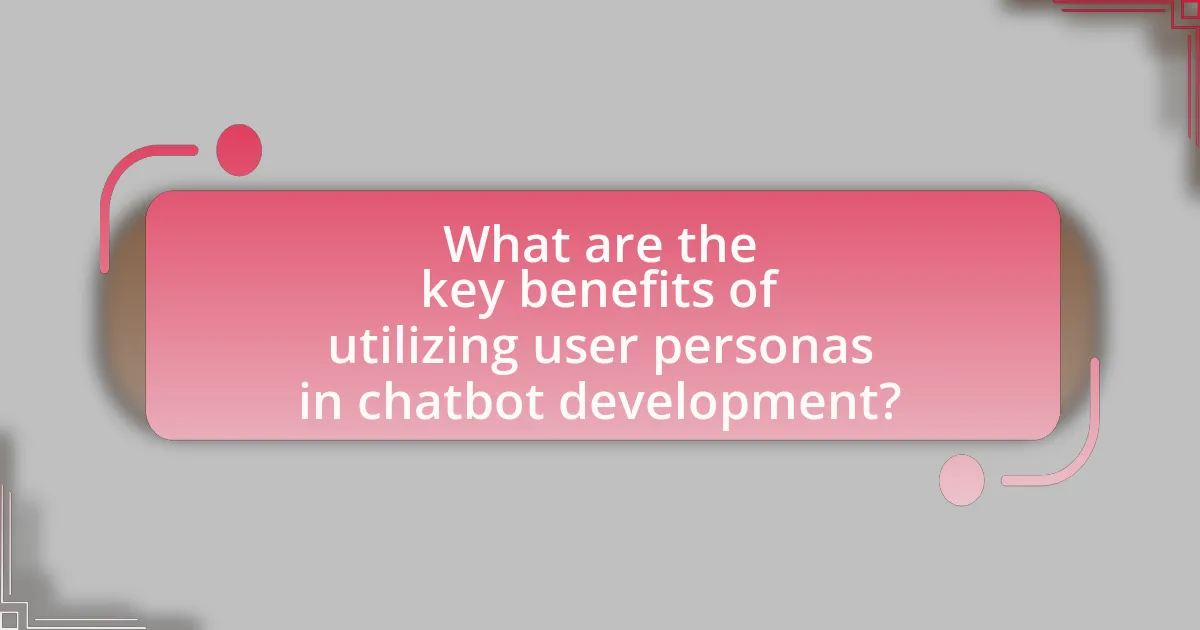
What are the key benefits of utilizing user personas in chatbot development?
Utilizing user personas in chatbot development enhances user experience, improves engagement, and increases the effectiveness of interactions. User personas provide a clear representation of target users, allowing developers to tailor chatbot responses and functionalities to meet specific needs and preferences. Research indicates that personalized experiences can lead to a 20% increase in user satisfaction and a 30% boost in engagement rates. By understanding user motivations and behaviors through personas, developers can create more relevant and intuitive chatbots, ultimately driving higher conversion rates and customer loyalty.
How do user personas improve chatbot design?
User personas improve chatbot design by providing a clear understanding of target users’ needs, preferences, and behaviors. This understanding allows designers to create more tailored and effective conversational experiences. For instance, research indicates that chatbots designed with user personas in mind can achieve higher user satisfaction rates, as they address specific pain points and expectations of different user segments. By incorporating detailed user personas, developers can enhance the relevance and efficiency of chatbot interactions, ultimately leading to increased user engagement and retention.
What specific design elements are influenced by user personas?
User personas influence several specific design elements in chatbot development, including tone of voice, user interface layout, and feature prioritization. The tone of voice is tailored to resonate with the target audience’s preferences, ensuring that the chatbot communicates in a relatable manner. The user interface layout is designed based on the personas’ behaviors and preferences, optimizing navigation and accessibility. Feature prioritization is guided by the needs and pain points identified in the personas, ensuring that the most relevant functionalities are developed first. These design elements are critical for creating an engaging and effective user experience that aligns with the expectations of the intended users.
How can user personas lead to more intuitive interactions?
User personas can lead to more intuitive interactions by providing a clear representation of target users, which helps in designing experiences that align with their needs and preferences. By understanding the specific characteristics, behaviors, and motivations of different user segments, developers can tailor chatbot responses and functionalities to meet user expectations effectively. Research indicates that user-centered design, which incorporates personas, can enhance usability and satisfaction, as it allows for the creation of more relevant and engaging interactions. For instance, a study by Nielsen Norman Group found that user personas improve design outcomes by ensuring that user needs are prioritized throughout the development process, leading to a more seamless and intuitive user experience.
What impact do user personas have on chatbot performance?
User personas significantly enhance chatbot performance by tailoring interactions to meet specific user needs and preferences. By understanding the demographics, behaviors, and pain points of target users, developers can design chatbots that provide relevant responses, improving user satisfaction and engagement. Research indicates that chatbots utilizing user personas can achieve up to a 30% increase in user satisfaction scores, as they are better equipped to address individual queries and concerns effectively. This targeted approach not only streamlines communication but also fosters a more personalized experience, leading to higher retention rates and overall effectiveness in achieving business objectives.
How do user personas contribute to higher engagement rates?
User personas contribute to higher engagement rates by enabling tailored interactions that resonate with specific audience segments. By understanding the demographics, preferences, and behaviors of target users, businesses can design chatbots that address individual needs and provide relevant content. Research indicates that personalized experiences can increase engagement by up to 80%, as users are more likely to interact with content that feels relevant to them. This targeted approach not only enhances user satisfaction but also fosters loyalty, leading to sustained engagement over time.
What metrics can be used to measure the effectiveness of user personas?
Metrics used to measure the effectiveness of user personas include user engagement rates, conversion rates, user satisfaction scores, and task completion rates. User engagement rates indicate how often users interact with the chatbot, reflecting the relevance of the personas. Conversion rates measure the percentage of users who complete desired actions, demonstrating the effectiveness of the personas in guiding user behavior. User satisfaction scores, often gathered through surveys, provide insights into how well the personas meet user needs. Task completion rates assess the efficiency of users in achieving their goals with the chatbot, highlighting the personas’ alignment with user expectations. These metrics collectively validate the impact of user personas on chatbot performance and user experience.
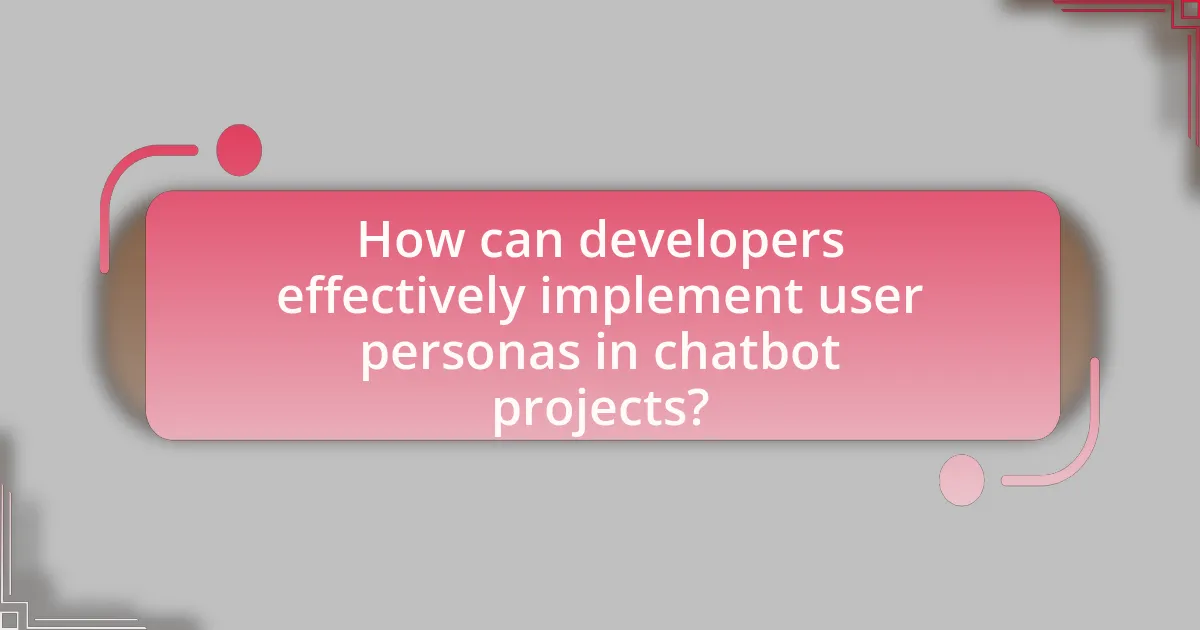
How can developers effectively implement user personas in chatbot projects?
Developers can effectively implement user personas in chatbot projects by conducting thorough user research to identify distinct user characteristics and needs. This process involves gathering data through surveys, interviews, and analytics to create detailed profiles that represent target users. By integrating these personas into the chatbot design, developers can tailor interactions, language, and functionalities to meet the specific preferences and pain points of users. Research shows that using user personas can enhance user engagement and satisfaction, as evidenced by a study from the Nielsen Norman Group, which found that user-centered design approaches lead to a 50% increase in user satisfaction.
What best practices should be followed when using user personas?
When using user personas, best practices include ensuring that personas are based on real user data, regularly updating them, and involving cross-functional teams in their development. Real user data enhances accuracy, as studies show that data-driven personas lead to better user engagement and satisfaction. Regular updates are essential because user needs and behaviors evolve; research indicates that 70% of user preferences change over time. Involving cross-functional teams fosters diverse perspectives, which can improve the depth and applicability of the personas, as collaboration often leads to more comprehensive insights.
How can developers ensure user personas remain relevant over time?
Developers can ensure user personas remain relevant over time by regularly updating them based on user feedback and behavioral data. Continuous analysis of user interactions with chatbots allows developers to identify shifts in user needs and preferences, ensuring that personas accurately reflect the target audience. For instance, a study by Nielsen Norman Group emphasizes the importance of iterative user research, which reveals that user behaviors can change significantly over time, necessitating updates to personas to maintain their effectiveness in guiding design and development.
What common pitfalls should be avoided in persona development?
Common pitfalls to avoid in persona development include relying on assumptions rather than data, which can lead to inaccurate representations of users. For instance, creating personas based solely on anecdotal evidence or internal opinions can result in a disconnect between the personas and actual user needs. Additionally, failing to update personas regularly can cause them to become outdated, as user behaviors and preferences evolve over time. Research indicates that 70% of companies that utilize personas do not revisit them, leading to ineffective user engagement strategies. Lastly, overcomplicating personas by including excessive details can dilute their effectiveness; a focused, streamlined persona is more actionable and easier to implement in chatbot development.
What tools and resources are available for creating user personas?
Tools and resources available for creating user personas include online platforms like Xtensio, UserForge, and HubSpot’s Make My Persona tool. These platforms provide templates and guided processes to help users gather demographic data, behavioral insights, and user motivations. Additionally, research methods such as surveys, interviews, and analytics tools like Google Analytics can be utilized to collect relevant data that informs persona development. According to a study by Nielsen Norman Group, user personas enhance user experience design by providing a clear representation of target users, which supports the effectiveness of these tools in creating accurate personas.
Which software can assist in persona development for chatbots?
Software that can assist in persona development for chatbots includes tools like Userforge, Xtensio, and HubSpot’s Make My Persona. Userforge allows teams to collaboratively create detailed user personas, while Xtensio offers templates for visual persona creation, enhancing clarity and focus. HubSpot’s Make My Persona provides an interactive experience for generating personas based on user input, streamlining the process. These tools are widely recognized for their effectiveness in helping developers understand user needs and preferences, which is crucial for creating engaging and effective chatbots.
What methodologies can be applied to refine user personas?
To refine user personas, methodologies such as user interviews, surveys, and analytics review can be applied. User interviews provide qualitative insights into user behaviors and motivations, while surveys can gather quantitative data from a larger audience, helping to identify trends and preferences. Analytics review involves examining user interaction data to understand how users engage with products or services, which can highlight areas for improvement in persona accuracy. These methodologies collectively enhance the understanding of user needs and behaviors, leading to more effective and targeted user personas in chatbot development.
What are the common challenges faced when utilizing user personas in chatbot development?
Common challenges faced when utilizing user personas in chatbot development include the difficulty in accurately representing diverse user needs and behaviors, as well as the risk of oversimplification. Accurately capturing the complexity of user interactions can lead to personas that do not reflect real-world scenarios, resulting in ineffective chatbot responses. Additionally, maintaining updated personas is challenging, as user preferences and behaviors evolve over time, which can render previously developed personas obsolete. Research indicates that 70% of organizations struggle with persona accuracy, highlighting the importance of continuous user research to ensure relevance and effectiveness in chatbot design.
How can developers overcome resistance to using user personas?
Developers can overcome resistance to using user personas by demonstrating their value through data-driven insights and real-world examples. By presenting case studies that show how user personas have led to improved user engagement and satisfaction in similar projects, developers can illustrate the tangible benefits of adopting this approach. Research indicates that organizations utilizing user personas experience a 20% increase in user satisfaction and a 30% reduction in development time due to clearer user requirements. Engaging stakeholders in workshops to collaboratively create and refine personas can also foster buy-in, as it allows team members to see firsthand how personas can guide design decisions and enhance the overall user experience.
What strategies can be employed to address inaccuracies in user personas?
To address inaccuracies in user personas, organizations can employ strategies such as continuous user research, iterative persona updates, and cross-functional team collaboration. Continuous user research involves regularly gathering data through surveys, interviews, and analytics to ensure personas reflect current user behaviors and needs. Iterative persona updates require teams to revisit and revise personas based on new insights, ensuring they remain relevant over time. Cross-functional team collaboration encourages input from diverse perspectives, enhancing the accuracy of personas by incorporating insights from different departments, such as marketing, sales, and customer support. These strategies collectively enhance the reliability of user personas, leading to more effective chatbot development and user engagement.
What practical tips can enhance the use of user personas in chatbot development?
To enhance the use of user personas in chatbot development, developers should focus on creating detailed, data-driven personas that reflect actual user behaviors and preferences. This involves conducting thorough user research, including surveys and interviews, to gather insights about target users’ demographics, goals, and pain points. Additionally, regularly updating personas based on user feedback and analytics ensures they remain relevant and effective. Implementing scenarios and use cases for each persona can also guide the chatbot’s design and functionality, ensuring it meets user needs effectively. Research indicates that companies using well-defined user personas in product development see a 20% increase in user satisfaction, demonstrating the tangible benefits of this approach.
